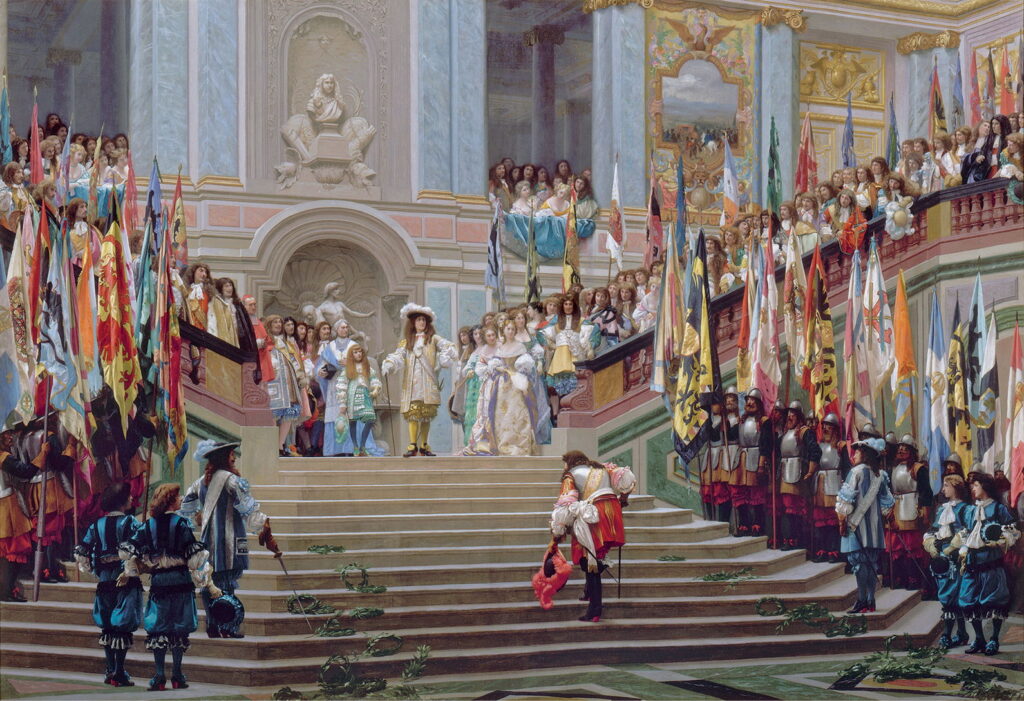The Truthful Vision of Jean-Léon Gérôme 4

As German forces closed on Paris in 1870, at the height of the Franco-Prussian War, Jean-Léon Gérôme fled to London, returned to Paris briefly in the autumn/fall, then went back to London. He finally returned to Paris in June 1871, after the suppression of the Paris Commune. Next came his most famous work, in a return to his Roman gladiatorial theme.
Jean-Léon Gérôme (1824–1904), Pollice Verso (1872), oil on canvas, 96.5 x 149.2 cm, Phoenix Art Museum, Phoenix, AZ. Wikimedia Commons.
Gérôme had started work on his most famous painting of all, Pollice Verso (1872), before 1869, but had temporarily abandoned it during the war. It wasn’t, therefore, intended as comment on that war, nor about France’s sudden transition from Second Empire to Third Republic. Instead, Gérôme looks at the power of expression, here a small gesture of the hand, in his favourite context, the gladiatorial arena, that he had fallen in love with when he was first in Rome in 1843. It also develops a theme from his earlier Ave Caesar: that of spectators and their complicity in the horrific events taking place in front of them.
His earlier paintings of the arena had been troubled by difficulties in achieving historical accuracy in armour, weapons, and other details. Far from being a flight of fancy, Gérôme spent a great deal of time and effort trying to make everything shown in this painting as historically accurate as possible at the time, as the success of his painting depended on its fine details.
To be able to bring out those fine details, and the thumb gesture which was central to its title and theme, Gérôme had to draw in from the wide-screen spectacle of Ave Caesar, and concentrate on the gladiators, and a small section of the spectators, including the emperor, his court, and those closest to him, the row of six Vestal Virgins to the right.
The victorious gladiator stands with his right foot on the throat of the loser. He looks up at the crowd, to see whether he should kill that loser, indicated by thumbs pointing downward, or should spare his life, shown by thumbs pointing up. The title confirms what we can see: thumbs are down, and the gladiator on the ground is about to be brutally killed.
Jean-Léon Gérôme (1824–1904), Pollice Verso (detail) (1872), oil on canvas, 96.5 x 149.2 cm, Phoenix Art Museum, Phoenix, AZ. Wikimedia Commons.
Critical commentary became focussed on the row of Vestal Virgins; in Gérôme’s earlier Ave Caesar, they had been sufficiently distant that their expressions and body language couldn’t be read. Here he left no doubt: they are baying for blood, which some critics found frankly revolting. However, it speaks clearly about the Romans’ enjoyment of such events, and a moment’s reflection should make us think more deeply about our own fascination in the suffering of other humans and animals.
This painting was first shown at a private Salon in 1873. Goupil turned it into a highly lucrative series of prints, selling strongly until well into the twentieth century. For Gérôme it also provided figures for his first full-scale sculpture The Gladiators, a huge success of the Exposition Universelle in 1878, and now in the Musée d’Orsay.
Pollice Verso had the unintended consequence of making thumbs up and down signs part of the universal non-verbal vocabulary. The Romans did use hand signs involving the thumb to indicate their approval of gladiators killing their losers, but it is now thought that those were more complex than shown by Gérôme. This painting appears to have been responsible, in part at least, for defining the meaning of thumbs-up and thumbs-down gestures in popular communication.
With the days of the Second Empire past, Gérôme now had to paint for the Third Republic, and the many changes it was to bring to French society. He had found favour with Napoleon III and his court, and had received Imperial commissions. His history paintings of Napoleon Bonaparte from the mid-1860s would hardly do well with the Emperor and Empress in exile in Britain, and the French nation shocked by defeat, and divided in its reactions.
Jean-Léon Gérôme (1824–1904), A Collaboration – Corneille and Molière (1873), oil on panel, 48 x 67 cm, Private collection. The Athenaeum.
Perhaps feeling that the sixteenth century was safer ground, Gérôme captured two great French playwrights apparently working together in A Collaboration – Corneille and Molière of 1873. Jean-Baptiste Poquelin (1622-73), universally known by his stage name of Molière, was without doubt France’s greatest comic playwright of the era, and is shown at the left. At the right, Pierre Corneille (1606-84) was the greatest tragic playwright of the era. What better combination could there have been for French theatre?
This proved to be more than just a hypothetical question in 1919, when it was first seriously proposed that some, or many, of Molière’s plays had in reality been written, or ghost-written, by Corneille, a controversy that still smoulders on. The two playwrights did in fact meet, possibly in this way, when they collaborated with Philippe Quinault in the writing of Psyché in 1671.
For Gérôme, this may have been a public expression of his desire to bury the hatchet, and for Republicans and their opponents to get on with rebuilding the nation together. This was exhibited at the Salon in 1874, from where it was sold to a New York collector for thirty thousand francs.
Jean-Léon Gérôme (1824–1904), L’Éminence Grise, Le Père Joseph (1873), oil on canvas, 68.5 x 101 cm, Museum of Fine Arts, Boston, MA. Wikimedia Commons.
Accompanying this at that Salon was this intricate painting of L’Éminence Grise, Le Père Joseph (1873), the shadowy figure who was the right-hand man of the notorious Cardinal Richelieu (1585-1642), King Louis XIII’s First Minister of State from 1624. François Leclerc du Tremblay (1577-1638), known ever since as the Éminence Grise from his grey friar’s robes, had been a Capuchin friar when he first met Richelieu, and the two became close. Père Joseph often acted as the Cardinal’s diplomatic representative, and even war minister.
Gérôme was astute in this choice of subject, given the strong anti-clericalism of the Third Republic, and the distrust of ruling cliques, particularly those based in the Catholic church. But, as ever, there is more to this painting than its superficial story: Gérôme shows a dazzling display of finely dressed nobles bowing deeply at the sombrely dressed Père Joseph, whose head is buried deep in a book. This is again about signs and appearance.
This painting was sold to a New York collector shortly after completion, and exhibited at the Salon the following year, and again at the Exposition Universelle in 1878.
Jean-Léon Gérôme (1824–1904), Markos Botsaris (1874), oil on canvas, 70.2 x 54.6 cm, Private collection. The Athenaeum.
The following year, Gérôme again refused to be drawn into painting recent history in France, opting for two historical portraits of fascinating relevance. Markos Botsaris (1874) had been a great Greek general in the early quarter of the nineteenth century, and lived between about 1788-1823. He had been the main military leader of the Greek War of Independence from 1821-23, and remains a revered figure in modern Greece. He died when shot in the head during the Battle of Karpenisi.
Gérôme’s portrait shows a brooding figure in Orientalist dress, slumped deep in his ornate chair, bristling with knives, swords, and weapons, longing for his country’s freedom from the Ottoman Empire.
Jean-Léon Gérôme (1824–1904), Saint Jerome (1874), oil on canvas, 69 x 93 cm, Städelsches Kunstinstitut und Städtische Galerie, Frankfurt, Germany. Wikimedia Commons.
Saint Jerome (1874) stands in complete contrast: this ascetic saint is seen during one of his sojourns in the desert, almost naked, asleep on a lion, one of his better-known attributes. Over on a rock table is Jerome’s translation of the Bible, which he made between 392-405. For someone who so seldom painted religious works, this is an interesting excursion.
This painting had apparently been lost for many years, until its recent rediscovery: it was exhibited at the Exposition Universelle in Paris in 1878, but seems to have vanished a few years later, and wasn’t rediscovered until 2011, when the Städel Museum in Frankfurt came across it in its store.
Jean-Léon Gérôme (1824–1904), Circus Maximus (1876), oil on panel, 86.5 x 155 cm, Art Institute of Chicago, Chicago, IL. The Athenaeum.
Gérôme hadn’t forsaken the spectacle of the Roman arena. Circus Maximus (1876) is his recreation of four-horse chariot racing in the largest of all the stadiums in the city, capable of holding a crowd of over 150,000. Now a public park, in its heyday its oval track was about a mile in length. But the great strengths of Gérôme’s previous paintings – their widescreen illusion, the shocking gore in the arena itself, and the spectators baying for blood – were lost in this work, and I find it one of Gérôme’s few works that leaves me cold.
In spite of this, Goupil had no difficulty selling this work almost immediately on completion, to a New York collector, for 125,000 francs.
Jean-Léon Gérôme (1824–1904), Reception of Le Grand Condé by Louis XIV at Versailles in 1674 (1878), oil on canvas, 96.5 x 139.7 cm, Musée d’Orsay, Paris. Wikimedia Commons.
Gérôme returned to French history of two centuries before in one of his most elaborately detailed and almost hyperreal works, Reception of Le Grand Condé by Louis XIV at Versailles in 1674 (1878). Louis de Bourbon (1621-1686), the Grand Condé, was a notable French general and noble, representative of the Condé branch of the royal House of Bourbon, who was a distinguished leader of the French army during the Thirty Years’ War.
By 1650, the Grand Condé had fallen out of favour at court, and with the Regent Anne of Austria in particular, who had him arrested early that year for participation in the Fronde civil wars. He was pardoned in the Treaty of the Pyrenees in 1659, which formally ended the Franco-Spanish War, and accepted the authority of King Louis XIV. On returning from exile, the Grand Condé was received by the king at Versailles in 1674, following his military victory at the Battle of Seneffe against William of Orange. Here he is slowly ascending the steps between laurel wreaths of victory, and captured enemy standards at the edges, bowing with respect at the king before him.
According to Gérôme’s note to the American collector William H Vanderbilt who bought this work, the Grande Condé then said: “Sire, I beg your majesty’s pardon for making him wait so long,” to which the king replied “My cousin, do not hurry. When you are laden with so many laurels, it is difficult to walk fast.”
This may appear an odd subject for a painting eight years into the new republic, and more than a little revanchist in its reference to previous military victory over William of Orange. But it was a grand piece of escapism, and very different from his remaining three paintings from this period.
Jean-Léon Gérôme (1824–1904), Solomon’s Wall, Jerusalem (1869), oil on canvas, 92.1 x 73 cm, Private collection. Wikimedia Commons.
Solomon’s Wall, Jerusalem (1869) is the first of two paintings often considered to be stock Orientalist views. This wall purported to have been built around the city of Jerusalem by King Solomon between 1000-900 BCE is now most strongly associated with places in which Jews have traditionally gathered to lament the destruction of the Temples. This version, painted shortly before the outbreak of the Franco-Prussian War and the collapse of the Second Empire, shows a small scatter of people in different dress weeping at the foot of the wall’s massive limestone blocks.
Jean-Léon Gérôme (1824–1904), The Wailing Wall (Solomon’s Wall) (1877), oil on canvas, 72.4 x 59.7 cm, Israel Museum, Jerusalem. Wikimedia Commons.
Eight years later, post-war and well into the Third Republic, Gérôme painted The Wailing Wall (Solomon’s Wall) (1877), which I think is the more moving for its simplicity of motif. Was France perhaps now at its own wailing wall?
During the late 1870s, Gérôme concentrated on Orientalist views, and relatively narrative-free works derived from them. He hadn’t abandoned his Roman project, nor had he lost his interest in the metanarrative of paintings, and his first narrative work of the 1880s showed there was still more to come.
References
Ackerman GM (2000) Jean-Léon Gérôme, Monographie révisée, Catalogue Raisonné Mis à Jour, (in French) ACR Édition. ISBN 978 2 867 70137 5.
Scott Allan and Mary Morton, eds. (2010) Reconsidering Gérôme, Getty. ISBN 978 1 6060 6038 4.
Gülru Çakmak (2017) Jean-Léon Gérôme and the Crisis of History Painting in the 1850s, Liverpool UP. ISBN 978 1 78694 067 4.
de Cars L et al. (2010) The Spectacular Art of Jean-Léon Gérôme (1824-1904), Skira. ISBN 978 8 85 720702 5.




